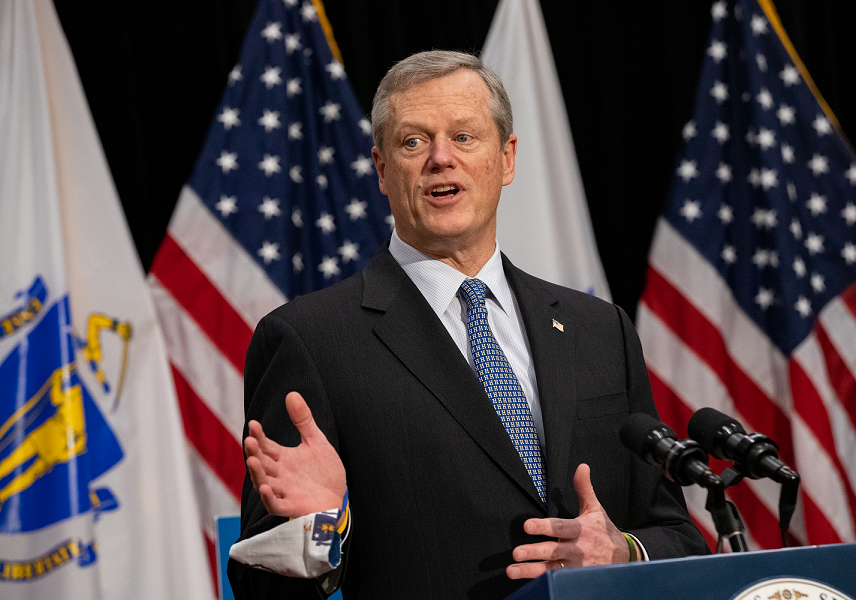latest
Baker proposes spending cut in pandemic recovery budget, no tax increases for residents

By Colin A. Young
JAN. 27, 2021…..Eyeing the state’s post-pandemic future, Gov. Charlie Baker on Wednesday proposed a $45.6 billion state budget for the fiscal year that starts July 1 that he said would make key investments and support the ongoing public health response to COVID-19, but would actually cut total state spending.
The proposed fiscal year 2022 budget does not include any tax increases on residents and would trim state spending by about $300 million or 0.7 percent while state tax revenue is expected to rise 3.5 percent over the current budget year.
“The budget fully funds the first year of the landmark Student Opportunity Act, provides substantial resources to promote economic growth and development as we work to recover, and helps ensure that public health during a pandemic continues to be there for us, all without raising taxes,” Baker said. “We don’t believe raising taxes on the residents of the commonwealth, especially in the midst of all that’s going on, is the right thing to do.”
The budget bill is built on a base of $30.12 billion in state revenue (roughly 3.5 percent growth over fiscal 2021), supplemented by an estimated $12.47 billion in federal revenue (down from $13.77 billion estimated for the current budget year), revenue generated by state departments and agencies, fees and other sources.
As Baker and Lt. Gov. Karyn Polito had previously announced, the fiscal 2022 spending plan (H 1) recommends increasing the state’s $1.13 billion general local aid account by $39.5 million and seeks to fully fund the 2019 school finance reform law that aims to steer $1.5 billion to K-12 schools over seven years.
The proposed reduction in overall state spending is due largely to slower-than-expected growth in MassHealth enrollment, officials at the Executive Office of Administration and Finance said. The administration had been expecting MassHealth enrollment to grow by about 1.5 percent each month during the pandemic, but it has actually come in at just under 1 percent growth per month.
Gross MassHealth spending is budgeted to fall from $18.2 billion this year to $17.6 billion in fiscal 2022, a 3.4 percent reduction, while all non-MassHealth spending in the governor’s proposed fiscal 2022 budget is slated to increase by 1 percent, from $27.7 billion to $28 billion, the administration said.
“With the exception of savings due to MassHealth utilization and savings from the elimination of a number of line-items, the Governor’s budget proposes modest budget growth, with new spending targeted for implementation of the Student Opportunity Act ($246.3 million in new spending), expansion of behavioral health services, increased costs for [the Department of Developmental Services] and [the Department of Mental Health] ($201.8 million) and increased local aid ($39.5 million),” the Massachusetts Taxpayers Foundation wrote in its analysis of the governor’s proposal. “House 1 focuses on level funding many programs and increasing spending where necessary to protect and maintain existing services as opposed to a focus on new initiatives.”
One-Time Revenues
Baker’s seventh budget would rely on up to $1.6 billion in one-time revenues drawn from the state’s rainy day fund, the administration said. The current year’s budget, a $45.9 billion plan signed in December, leans heavily on one-time revenues, including more than $2.76 billion in federal COVID-19 funding and a draw of $1.7 billion from the state’s rainy day fund.
“Replacing that revenue is among the biggest challenge budget writers face in balancing the FY2022 budget,” Mass. Taxpayers Foundation said as it also flagged that Baker is using $64 million in one-time revenues from further delaying a charitable contribution tax deduction and proposes to raise an additional $75 million in one-time revenues by hiking an existing assessment on hospitals.
The administration said fiscal year 2021 began in July with a stabilization fund balance of $3.501 billion. It expects a net reduction of $978 million from the fund over the course of fiscal 2021 — a $1.7 billion draw partially offset by the addition of $120 million from excess capital gains taxes statutorily required to go to the rainy day fund and a recent tax collection upgrade that nets $602 million for the current budget. That would put the rainy day fund at a balance of $2.523 billion to start fiscal 2022, the administration said.
After accounting for about $182 million in projected excess capital gains tax revenue, the proposed withdrawal of $1.6 billion in fiscal 2022 would leave the state’s piggy bank with a balance of $1.105 billion as of July 1, 2022. Baker pointed out a few times Wednesday that the stabilization fund would end fiscal 2022 “at the same level it was at when we took office.” The fund’s balance was actually more than 13 percent higher — $1.252 billion — at the end of fiscal 2015, about six months into Baker’s first term, according to the state’s comptroller.
If the federal government makes more relief funding available to states or if the tax collection picture brightens further, the use of rainy day fund money in fiscal 2022 would be reduced, an administration official said. Though the Biden administration has talked about a $1.9 trillion stimulus package, the administration official said Baker’s budget office won’t count any of that potential money towards the state budget until a bill is signed into law.
In June 2017, S&P Global Ratings lowered its credit rating for Massachusetts bonds to AA from AA+, largely due to the state diverting money from its stabilization fund while the economy was growing. In fiscal 2022, the administration is proposing to draw from the stabilization fund even as state tax revenues are projected to grow by 3.5 percent.
Administration and Finance Secretary Michael Heffernan said Wednesday that he is not concerned that the rating agencies might frown upon the state’s use of its rainy day fund this time around given how different the overall economic picture is.
“It is still raining, COVID is still very much here, the response is still very much here. We want to get kids back in school, we have over 300,000 people on unemployment. This is a time when the state is needed the most. And so we’re budgeting, as I said, from a response to recovery to make sure that we have the right resources in the right place at the right time,” he said. Heffernan added, “I think this is exactly what the stabilization fund is made for.”
The governor’s budget also incorporates legislation that would legalize betting on pro sports in Massachusetts (and counts on about $35 million in revenue from the activity), doubles the budget for the Massachusetts Emergency Management Agency to $4.1 million to allow the agency to do more in-depth reviews of emergency management plans, boosts Emergency Assistance Family Shelter System funding by 8 percent to $195.9 million, provides $30 million to address recommendations from the Black Advisory Commission and the Latino Advisory Commission, directs $357.3 million towards efforts around substance misuse, funnels a total of $1.36 billion to the MBTA, and makes $415.3 million available for State Police public safety and crime lab operations.
The Path to July 1
Now that Baker has kickstarted the budget process with his filing, attention turns to the Legislature. The House will likely refer the governor’s bill to its Ways and Means Committee, which will redraft it to reflect House priorities. The House usually debates its budget in April and the Senate, which will also draw up a budget plan of its own, generally debates the budget in May. Fiscal year 2022 begins on July 1.
“As the budget process proceeds, the Governor’s budget provides the legislature with much to consider. The use of $1.6 billion from the Stabilization Fund would put a significant dent in available reserves, while several of House 1’s revenue proposals – including new assessments on hospitals and pharmaceutical companies – require more information on the likely impact on the health care system,” Mass. Taxpayers Foundation said. “In order to craft a responsive and responsible FY 2022 budget, policymakers will need to closely monitor state tax collection trends and further federal stimulus legislation.”
Halfway into fiscal year 2021, state government had collected $372 million more in taxes from people and businesses than it did during the same six pre-pandemic months of fiscal year 2020. The mid-January update from the Department of Revenue showed that tax collections about halfway through the month were up $313 million or 25.5 percent over the same period of January 2020.
Full January revenue figures are due to be released next week and Baker said Wednesday that the state’s tax revenue picture remains “somewhat unpredictable.”
-

 Community6 years ago
Community6 years agoNational Shrine of La Salette Festival of Lights 2017 set to begin
-

 Community6 years ago
Community6 years agoMassachusetts State Police looking for good home for retired dogs
-

 Crime6 years ago
Crime6 years agoFall River ranked most dangerous city in Massachusetts according to report
-

 latest6 years ago
latest6 years agoDurfee student allegedly overdoses on marijuana
-

 Community6 years ago
Community6 years agoVideo of Fall River Police goes viral
-

 Causes6 years ago
Causes6 years agoMissing Fall River woman found deceased
-

 Crime6 years ago
Crime6 years agoFall River Police add names to most wanted list
-

 Causes6 years ago
Causes6 years agoFall River teenager reported missing has been found




